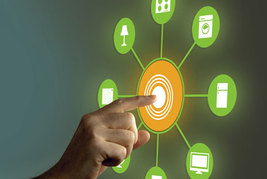
Here are five takeaways from this year’s event:
Home automation remains in the spotlightAs expected, home automation was one of the show’s biggest stars. There were new offerings from established manufacturers and providers like Honeywell, Interlogix, Alarm.com and Nortek. Google and Samsung each revealed more about their strategies, while Apple was conspicuous with its absence. And newer DIY players with names like MyFox, Smanos and Chuango joined existing offerings from iSmartAlarm, iControl and Canary.
Right now, it’s a land of confusion. But sooner or later, the market will shake out and the best solutions will bubble to the surface. In the meantime, no one could blame consumers for waiting to see who survives the competition before opening their wallets.
Stuck on self-monitoringHome security is acknowledged to be the centerpiece of home automation, but it’s surprising to see how many solutions still depend on self-monitoring rather than central monitoring.
That always brings us back to the same issues. How many consumers understand the responsibility of having to react quickly and correctly every time the smartphone signals an alarm? How many are ready to hand that responsibility off to a neighbor or family member instead of a trained professional? And how often will a homeowner have to sweat when they’re without cellular coverage, or stuck in a situation where they can’t instantly react?
Being able to monitor your house remotely sounds like a great idea, but it’s hard not to recognize the value of professionally monitored systems.
The camera will be kingWired magazine noted that some of the most useful smart-home solutions are variations of good old video cameras. They’re becoming smarter as they begin to incorporate technology for facial recognition, threat assessment, environmental control, or even health monitoring.
As video gets more affordable, practical and versatile, it may become very appealing to consumers who have already come to accept the fact that cameras practically watch our every move. It would be a small leap to being comfortable with having one in your home, particularly when it offers powerful functionality.
Sexy vs. practical – The media tends to sell a smart-home image of a fantasy world where all your household devices work together like a symphony. Wired offers a different vision: a relatively limited number of practical devices – not just video, but locks, thermostats, light bulbs and other devices you use each day – that will be useful, reliable and easy to control with your smartphone.
But hey, how can a remote-controlled front door compete with a flower pot that tells you whenever a houseplant needs to be watered?
Wonderful world of wearablesWearables were also big at CES this year. The emphasis was on not only expanding and improving functionality, but also making them a little more attractive.
The technology also went beyond what you can wear on your wrist:
- Skin sensors that will communicate a person’s temperature or other vital signs directly to a smartphone. There also was discussion of a temporary tattoo that could be used to track vital signs of hospital patients.
- Smart clothing that could theoretically take the place of a personal trainer, monitoring the effectiveness or technique of your exercise regimen.
- Last but not least, a belt that not only tracks your activity, but automatically adjusts when you sit or stand. As if that weren’t enough, it also reminds you that maybe it’s time to drop a few pounds.
Sources:
http://www.achrnews.com/articles/128464-jan-5-2015-home-automation-and-control-market-worth-1281-billion-by-2020
http://www.prnewswire.com/news-releases/home-automation-market-to-surge-to-us164-billion-by-2019-transparency-market-research-279917242.html
http://www.wired.com/2015/01/home-security-internet-things/
http://gadgets.ndtv.com/wearables/features/ces-2015-wearables-roundup-646523
http://www.mirror.co.uk/news/technology-science/technology/ces-2015-top-10-wearable-4949652
